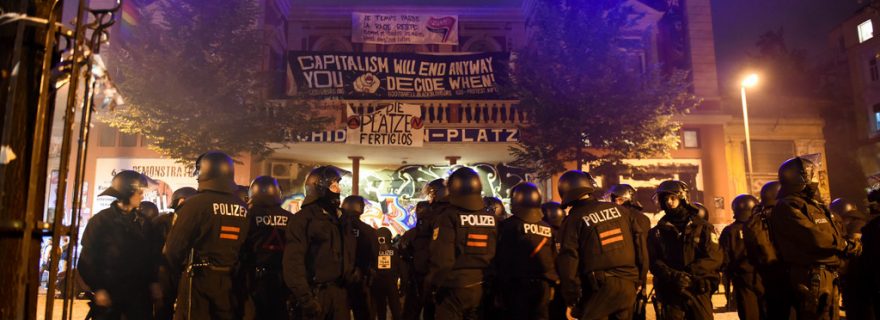Why the Far-Left Deserves More of Our Attention
Paying more attention to left-wing groups in academic research could increase our understanding of their political goals and modi operandi. It could also add more depth to our general understanding of radicalisation.
During the 2017 G20 summit in Hamburg, violent protests and clashes between anarchist and other radical left-wing activists and the police took place. This left behind injured people from both sides, broken streets, burning cars and damages worth millions of euros. More than 400 activists from all over Europe were arrested, and some of them have been sentenced to several years in prison. The media and politicians in Germany and other states were shocked by the violent protests. As a consequence, the militant activists were depicted as “criminal slobs” or “despicable extremists”. German politician Peter Altmaier (CDU) categorised these protests as ‘left-wing terror’ and put them on a similar scale with both Islamist and right-wing terrorism. Interestingly though, Left-wing radicalization has not gotten the same amount of attention as Islamist – or right-wing radicalization.
Since 9/11, the emergence of the Islamic State (IS) and several terrorist attacks in Europe, such as in Brussels (2014), Paris (2015) or Manchester (2017) and the issue of home-grown islamist radicalisation and extremism has re-surfaced on the agenda of European policymakers and scholars. As a result, de-radicalisation and prevention measures have been drafted on a policy level. Additionally, academic research into the phenomena of extremism and radicalisation, often summarised in the study of terrorism, has grown significantly as a 2018 study by Schuurman found. Whilst most of these studies have been focused on Islamist radicalization, the literature on the far right has grown in recent years, as populist right-wing parties have gained successes in elections throughout Europe. Left-wing radicalisation as a specific sub-category however, has often been neglected.
Whilst this focus seems justified with the rise of IS and recent terrorist attacks in Europe, statistics show that other forms of radicalisation are on the rise as well. Europol’s 2017 EU terrorism report sees a “sharp increase” in left-wing or anarchist terrorism and a rise of radical right-wing extremism in some EU countries on a “level causing concern to authorities”.
The numbers of members in anarchist, antifascist, autonomous or similar far-left groups have increased and their actions have been more visible in the last years. In 2011, thousands of protestors have gathered in the big cities in Europe to protest the current influence of large cooperations and their perceived negative influence on the “99%” rest of the world. Though this movement attracted people from different, but generally left-wing, backgrounds, many radical autonomous and anarchist groups took part in it as well. In early 2017, parcel bombs were sent to official institutions in both France and Germany. The attack was claimed by a Greek anarchist group, the Conspiracy of Cells of Fire. Later that year, two Italian anarchist groups claimed responsibility for a detonated bomb in front of a police station in Rome. The most recent attacks include bombings of a Greek TV station and a detonation device that injured two persons near a church in Athens.
Understanding the full impact of these attacks and the groups behind them is not easy, as there are only a handful of recent studies on radicalisation and extremism that involve left-wing ideological groups. Policymakers and scholars are therefore forced to fall back on studies of other forms, mainly islamist extremism, that may have never been intended for a broader application.
Paying more attention to left-wing groups could not only increase our understanding of the political goals, intentions or modi operandi of so far underrepresented groups in academic research, but it could also add more depth to our general understanding of the phenomenon of radicalisation. Instead of trying to find theories or counter-measures that can be applied to all forms of radicalisation, scholars and policymakers could benefit from a more differentiated perspective. Can and should we really apply what we have learned so far about radicalisation to all the different forms? Are there enough parallels between radicals of different ideologies? What are the differences and what can they teach us? Answering these questions in the upcoming years should be on the agenda of scholars and policymakers.


